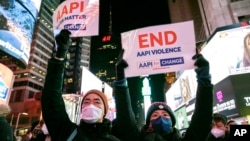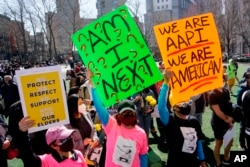Facing prejudice is, for most Asian Americans, an all-too-familiar part of life, a new report from the Pew Research Center shows.
The study, which is based on a survey of more than 7,000 respondents, found that the majority of Asian Americans think too little national attention is being paid to their experiences with discrimination.
About one-third of Asian Americans have been told to go back to their home country, the report found. Forty-four percent of Asian Americans ages 18 to 29 said they know an Asian person who has been personally threatened or attacked since the onset of the coronavirus pandemic.
There are about 23.5 million Asian Americans, making up 7.1% of the nation’s population. The year 2021 saw anti-Asian hate crimes in the U.S. jump to an all-time high, and 2022 was the second-worst year on record.
“Discrimination is nothing new against Asian Americans,” said Neil Ruiz, head of New Research Initiatives at Pew and the study’s co-author. Asian Americans have endured relentless stereotyping, reaching as far back as the 1800s, and Ruiz’s study highlights a paradox at the crux of that.
Asian American communities have for decades been typecast as model minorities: “loyal and hardworking,” as one respondent put it. On the other hand, Asian Americans have found themselves ostracized, treated as what scholars and activists have dubbed “forever foreigners.”
‘Forever Foreigner’ Trope
“We found that 78% of Asian Americans have been treated as a foreigner in some way, even if they were born in the United States,” Ruiz, an Asian American himself, told VOA. Criteria include being told to go back to one’s home country, being ridiculed for speaking a language other than English in public or having one’s name pronounced incorrectly.
Ruiz acknowledged that mispronouncing someone’s name can be an honest mistake. But for many of the study’s participants, these incidents have often bordered on disrespect or become outright offensive, he said.
Ruiz recounted how, in one focus group, an Indian American woman said she had a list of more than 200 ways her name had been mispronounced, leaving her feeling perpetually demeaned. Some reported that they had felt pressured to adopt Anglicized names.
Russell Jeung, a professor of Asian American Studies at San Francisco State University, said that fighting anti-Asian prejudice means creating spaces where people “feel free to share how they are hurt or how others might be hurt” by offhand remarks.
The harder question, activists say, is how to respond when it’s not just a coworker making derisive comments but former President Donald Trump or others in positions of authority, such as airport security personnel who, according to the study, screen South Asian Americans at markedly higher rates.
After Trump used offensive language during the pandemic, including calling the coronavirus the “Chinese virus,” the non-profit group Stop AAPI Hate found that use of anti-Asian slurs had risen online.
Having a tolerant national role model is “a matter of life or death,” Jeung said.
Days after 9/11, then-President George W. Bush delivered a speech at a mosque calling for respect for Islam. Hate crimes against Arab and South Asian Americans immediately fell, according to the Center for the Study of Hate & Extremism.
“American leaders have a very deficient understanding of the experiences and needs of a group as diverse as Asian America,” said Charles Jung, a Californian civil rights lawyer and community organizer.
National leaders, Jung said, have a responsibility to encourage tolerance and to bring communities together by highlighting shared values rather than perceived differences. “At a minimum, that means not saying racist things and inflaming hatred,” Jung said. “But that’s the bare minimum.”
Model Minority Stereotype
The notion that Asian Americans serve as a model for other minority groups has been perpetuated in popular media for generations. In 1966, The New York Times Magazine ran an article hailing Japanese Americans as a “success story.” In 1987, Time magazine ran a cover story describing Asian American children as “whiz kids.”
But Jung said the “model minority” stereotype is “certainly flattening and simplistic — a cartoonish view of an entire people who are incredibly diverse.”
The Pew survey found that most Asian Americans, particularly Indian Americans, had not heard of the term “model minority,” though most respondents said they had been presumed by peers to be good at math or uncreative — two stereotypes associated with Asians.
Karthick Ramakrishnan, a professor of public policy at the University of California, Riverside, and founder of AAPI Data, said that, compared with East Asian Americans, “the model minority myth is not as much of a barrier or a concern that South Asians have to deal with.”
“South Asians and East Asians experience racism and racial discrimination differently,” Ramakrishnan added, citing disproportionate security screenings and surveillance of South Asian Americans in the post-9/11 era.
Of the Asian Americans who were familiar with the term, 42% said the model minority stereotype is harmful.
There isn’t a consensus among Asian Americans: 17% thought the model minority stereotype is positive, a stance Republican Asian Americans are comparatively more likely to take.
Jeung counts himself among the 42% who believe the stereotype is damaging. He said it “drives a wedge between Asians and other racial groups. It also masks issues that Asians face: If we’re seen as a model, we’re seen as not having any particular problems. But clearly, we face racism.”
Jeung said the model minority stereotype belies a wide range of social issues that many Asian Americans confront in their day-to-day lives, from workplace discrimination (according to the Pew survey, about 1 in 5 Asian Americans said they had experienced anti-Asian workplace discrimination) to expectations of perfection in the classroom and beyond.
Despite the widespread problem of anti-Asian hate, the majority of Asian American adults said the challenges of racism were rarely, if ever, discussed in their households growing up.
“Sometimes, the adaptation that immigrant Asian parents adopt is swallowing the bitterness and pain,” Jung said.











